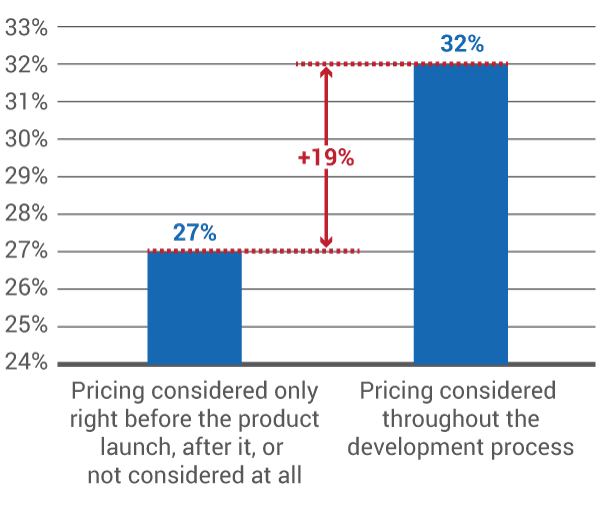How To Avoid Profit Cuts? Sharpen Your Pricing Strategy
Executive Summary
Findings from an industry survey forecast profit declines for medtech companies, among other things, if they do not take stock of weaknesses in their pricing strategy and fully tap into the profit potential of their new products.
Amidst increasingly oppressive market conditions, medical device companies are turning to new product-launches to keep their top-line buoyant. However, less-than-optimal pricing strategies still persist across the sector and many medtech manufacturers are not achieving their planned price increases, thus putting themselves at risk of seeing their bottom lines shrink.
These are some of the key findings from the Global Pricing Study 2016, a biannual industry survey conducted by strategy and marketing consultancy Simon-Kucher & Partners (SKP) in collaboration with the Professional Pricing Society. The survey received nearly 2,200 responses from senior executives across 16 different industries and of these, 97 responses (about 5% of the total sample) were from medtech companies in Europe, the US and Asia.
While pricing pressures in the medtech sector are not new, the situation has intensified – mainly due to the arrival of low-price competition and customers’ increasing negotiation power – to the extent that one in every two medtech companies are now engaged in a price war, the survey results showed. Additionally, companies have to deal with cost increases, which are driven by a mix of factors including higher personnel costs, higher cost of goods, currency fluctuation and inflation.
However, these companies, on average, have achieved only 83% of the price increase that they planned to implement. This shortfall is not enough to offset cost increases and profits are set to decline this year, SKP analysts predict. (See Figure 1.)
Figure 1 Estimated impact on return on sales Profits are set to decline by 1.2 percentage points, as insufficient price increases are unable to mitigate cost increases Simon-Kucher & Partners
Survey respondents revealed that one of the top methods medtech companies are using to counter these challenges is to introduce new, innovative or differentiated products which can command premium prices.
But pervasive inadequate pricing practices mean that the profit potential of these new products are not fully capitalized. A third of respondents in the survey said less than half (up to 40%) of products introduced to the market within the last five years met their profit targets, while half of the respondents said 40%-80% of new products met profit expectations. Only the remaining 20% said 80%-100% of the new product launches were successful. (See Figure 2.)
Figure 2
Question: "What share of new products reached expected profit target?"
% of respondents; medtech sample size = 97
Simon-Kucher & Partners
As to the reason behind this lackluster performance, the survey found that companies that neglect pricing and marketing activities around these new products were less likely to realize the profit potential of these innovations. Digging deeper, the study findings showed that the share of successful product launches increases by nearly 20% when a company takes pricing into account continually – from the start of the product development process through to the launch – rather than neglecting or ignoring them until right before the launch. (See Figure 3.)
Figure 3 Share of new products that meet profit targets By taking pricing into account throughout the development process, the share of successful product launches increases from 27% to 32% Simon-Kucher & Partners
Joerg Kruetten, head of SKP’s global life sciences practice, told Medtech Insight why factoring pricing early in a product’s lifecycle is critical. “Firstly, when you are making a business case to get that initial funding to develop new technology, you need to have a good understanding of that product’s price potential and its reimbursement potential. It’s important to consider before signing off on any R&D investment, whether you can get any reimbursement and whether you will get a sufficiently high price for the product.
“Secondly, along with the R&D process, having a good understanding of the end customer price and what your margin expectations are will help you to define a target cost and ensure that you do not exceed this cost. Thirdly, once you know the price potential and you know the value buttons that you need to push to convince payers and providers, this will help you design your clinical trials in such a way that they are meaningful – not only from a product approval perspective but also from a marketing point of view. So you will have a clear marketing message from the start,” said Kruetten, noting that the medtech industry could take some lessons from its pharma cousins on that aspect.
“For pharma, pricing and market access goes in parallel with R&D. For each project, there are pricing/market access checkpoints. If the company does not see sufficient market access [that would make the product commercially viable], they kill the project. And when pharma companies perform clinical studies, they use it to get regulatory approval, as well as to build their messages to stakeholders.”
Aside from ensuring pricing considerations are taken into account early and continuously from a product’s development through to launch, what factors actually make up an effective pricing strategy?
Findings from the survey showed that the “best” medtech companies – defined as such because they fulfilled SKP’s criteria for best pricing practices – placed high importance on three factors in particular: having the right systems, processes and sales skills.
Seven Steps To Take Now To Escape Price Pressure And Boost Profits
- Priorities: Make price strategy and price management your top priority – no price cuts without specific approval.
- Ambition: Set more ambitious price targets.
- Proprietary pricing approaches: Develop a tailor-made pricing strategy rather than rely on off-the-shelf solutions.
- Empowerment: Increasing prices almost always comes with volume risks, and vice-versa. Make sure that your incentives not only push volume, but also support price performance.
- People and organization: Invest in building up pricing departments and pricing competence, clarify roles and responsibilities for pricing activities.
- Leadership: Dedicate a fixed slot in your management meetings to price decisions.
- Digital-ready: Challenge whether your price model is still appropriate in the digitalization age.
Source: Simon-Kucher & Partners
For companies struggling to hit their pricing targets, Kruetten advises getting the right processes in place first by assigning clear pricing roles, and responsibilities and then ensuring this is well understood and executed by the sales organization. Once the “basics are in place, then incorporating the right systems – such as using dedicated support software to monitor and guide pricing – can then be the second or third step," he said.
“There is still no clear guidance in many companies for sales people about which price they should sell which product, at which level they should give discounts – this guidance often does not exist. So the salesperson makes the decision based on what they think is right. It is a very individual and opportunistic way of selling devices compared to other industries,” said Kruetten.
Price monitoring is also something that is not that common, even though there are pricing support tools available that can facilitate this. Kruetten pointed out the benefits of more bespoke pricing software, which “best” companies use more frequently than other less competitive companies, as the survey revealed.
“What we are seeing is that best-in-class companies have their own software developed and they integrate it into their other systems rather than relying on off-the-shelf software. They have something more sophisticated to fit their needs,” said Kruetten.
Having these systems in place give these companies a better understanding of pricing decisions as they create transparency on the value of the product they are offering, know which prices to set for new product launches and implement the price targets planned. “With the digital solutions that are available right now, you can do much better price steering. When you are at a point of sale with a customer, you can discuss a certain deal and get online guidance on what price to sell it and what room there is to maneuver in terms of providing discounts. It can facilitate quicker and more effective price decision-making because you have the tools to allow you quicker access to the relevant data.”
While the medtech industry appears to be lagging behind other industries when it comes to adapting their pricing strategies to the changing market environment, “there is a lot of movement in the right direction," Kruetten believes. “There is room for improvement … but given that we have seen a lot of price erosion in the medical device world, the attention to pricing has increased and the need for action is becoming more urgent.”
For more information about the Global Pricing Study 2016, contact Nora Neuwinger of Simon-Kucher & Partners at [email protected]
From the editors of Clinica
